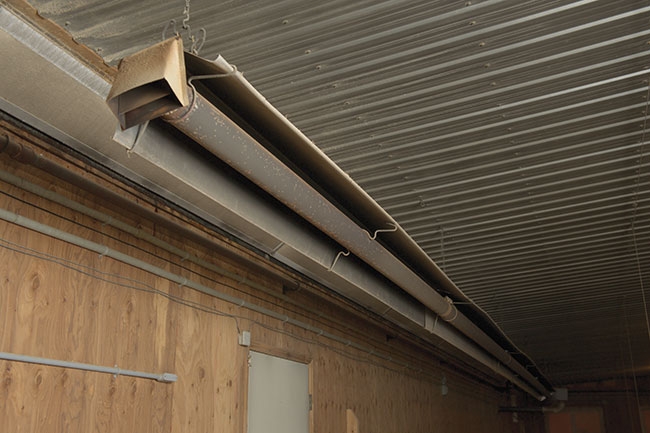
Preparing your poultry barn for winter
By Ben Kaiser
Features Barn Management Equipment Production Animal Housing annex Better poultry barns Canada Efficiency Energy Livestock Production Ontario Poultry Production Production Sustainability Ventilation Conduct a thorough checkup and clean up on boilers and heaters before the winter months hit. Photo Credit: Poultry Industry Council
Conduct a thorough checkup and clean up on boilers and heaters before the winter months hit. Photo Credit: Poultry Industry CouncilSummer has come and gone and fall is now here. It’s once again time to take a look at your maintenance program and go over the equipment to ensure everything is running efficiently.
Hopefully your fans have been able to hold up over the summer, especially considering the heat waves experienced in Ontario and Quebec. Now that the new season is here, though, we will be transitioning (hopefully gradually) to heating our barns. While the layers will not need heat for a while, pullets and chicks certainly will. So, let’s today focus on heating equipment and making sure it is ready for the colder seasons ahead.
I’m a big believer in doing a thorough checkup and clean up on boilers and heaters before the heating season hits. Few barns have redundant heating systems, so it is imperative that what you have is working well. Farmers often do everything themselves and make repairs with baler twine and duct tape. But, in many cases, bringing a professional in can save costs in the long run.
Having a good relationship with the local plumbers and electricians helps ensure that if or when an emergency hits, you have someone in your corner that knows your equipment and can come quickly to help out.
The truth is boilers are not so different than any other gas-fired apparatus. All modern equipment has similar components that make them safe to use and reliable. That said here are a few things to review to ensure everything is good to go for the winter.
Power
First, check the power. Are your voltages OK and within the specifications set by the manufacturer? One time, I hooked up a piece of equipment to 400 V because a manufacturer had put the wrong sticker on and fried the VFD. Indeed, making sure the power supply is correct is super important.
Safety circuits
Next, go through the safety circuit. If you’re unfamiliar with a wiring diagram or safeties, take the time to have someone walk you through them. Once you understand how they work, it really makes troubleshooting so much easier. The safety circuit is usually where most issues are found. On a boiler, I would check the high limits, operating temperature probes, pressure switches, flow switches, damper end switches and low water cut-off switches.
Fan switches
If you have something that deals with hot air (a heater, not your brother-in-law – I can’t help you with him!) then you’ll also need to go over your fan switches. I find that these can get stuck, especially if they haven’t been blown down or if a lot of moisture gets in them while they are dusty.
Relief valves
This might get me in a bit of trouble but on equipment that heats water check your temperature and pressure relief valves. Make sure they dump water when the temperature or pressure is too high. The thing is, especially on older equipment or equipment with grit in the water, there is a good chance that the pressure relief valve will not reset after you test it. You’ll end up having to replace the valve as a result. But trust me, replacing the valve is worth it – it is literally the last line of defence if something goes wrong.
For any of you interested, you can see what a residential hot water tank can do to a house on YouTube by searching for “Mythbusters water heater explosion”. I watched it like three times! The explosion is pretty cool. Seriously though, when a water pressure vessel decides to suddenly release pressure it can be a very dangerous situation. Making certain the temperature and pressure valve is operating properly is well worth the time. Just make sure you replace it with one of the proper rating. A hot water tank and a boiler have different styles and ratings for relief valves.
Venting and heat exchanger
Next, check the venting and your heat exchangers. If you’re dealing with a direct-fired piece of equipment, there is no venting as the unit is spewing fire directly into the air. But with boilers or indirect-fired heaters like home furnaces it’s important to check those items. A crack in your vent pipe or in your exchanger allows for dangerous gases like carbon monoxide to escape into the building. Cleaning your boiler’s exchangers and blowing dust off of them may also help with efficiency.
Boiler water
Then we have the actual water in the system. Take a minute to look over the piping in your boiler. You have plastic, aluminum, copper, brass, steel and stainless steel components all in the boiler water. Every one of those components will react differently depending on the water’s condition. Taking a small sample and sending it out to get tested can help increase the longevity of the system. Your local plumbing supply shop should be able to provide you with a company that can handle this.
Combustion
Finally, you’re left with the actual combustion of the unit. This will take a professional to test. Ensuring that the gas pressures are all within specifications and that the products of combustion are ideal for your piece of equipment is something that requires special tools and equipment. Conventional heaters are more forgiving with this than high efficiency ones are, but in both cases having your heater “dialled in” increases its lifespan and long-term efficiency.
Ben Kaiser is a master gasfitter and master plumber. He works with his father Martin and his three brothers at Kaiser Ag and specializes in poultry barn construction and installations.
Print this page